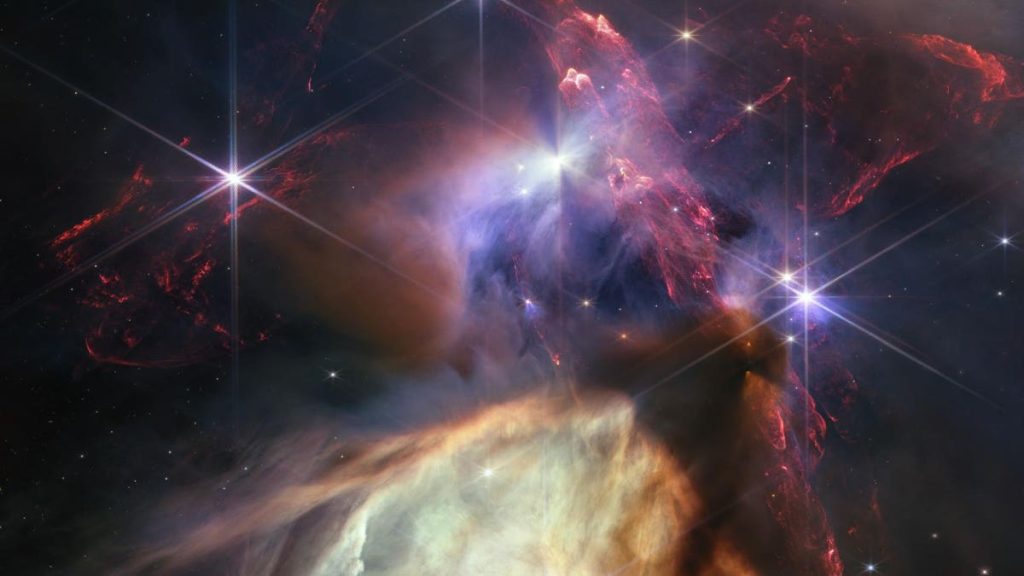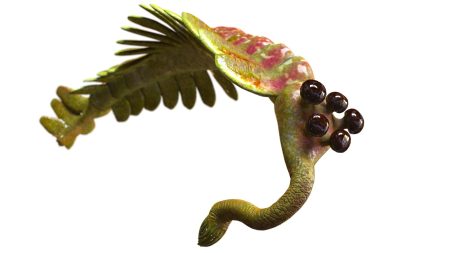It’s been exactly a year since the James Webb Space Telescope began its science operations—and to celebrate NASA has published a stunning new image.
The image—a small star-forming region in the Rho Ophiuchi cloud complex—was published to celebrate an entire year of science since its iconic “first light” debut images on July 12, 2022 of the Stephan’s Quintet galaxies, the Carina Nebula, the Southern Ring Nebula and the spectrum of exoplanet WASP-96b.
Rho Ophiuchi Revealed
At 390 light-years from the solar system, Rho Ophiuchi is the nearest star-forming region to us. Webb’s image shows about 50 sun-sized stars amid thick dust cocoons and red jets of molecular hydrogen.
“Webb’s image of Rho Ophiuchi allows us to witness a very brief period in the stellar lifecycle with new clarity,” said Klaus Pontoppidan, who served as Webb project scientist at the Space Telescope Science Institute in Baltimore, Maryland. “Our own sun experienced a phase like this, long ago, and now we have the technology to see the beginning of another’s star’s story,”
The new image is available to download from NASA right now, but it’s also being made available to download in very high resolution from the website of the from the Space Telescope Science Institute.
First Year in Space
The infrared space telescope’s first year has included several “Webb Deep Field” images that have shown astronomers a first glimpse of galaxies and stars closer to the Big Bang than ever before.
Webb found its first exoplanet and studied the atmospheres of many alien worlds. It also broke new ground in our solar system. Just a few weeks ago NASA published a stunning image of Saturn in infrared while in May, Webb spied a massive new plume of water vapor spilling into space from the ringed planet’s tiny moon Enceladus.
They came on the back of some astonishing images of Jupiter in infrared that revealed the giant planet’s incredible storms, cloud bands, faint aurora, rings and tiny moons.
“On its first anniversary, the James Webb Space Telescope has already delivered upon its promise to unfold the universe, gifting humanity with a breathtaking treasure trove of images and science that will last for decades,” said Nicola Fox, associate administrator of NASA’s Science Mission Directorate in Washington. “An engineering marvel built by the world’s leading scientists and engineers, Webb has given us a more intricate understanding of galaxies, stars, and the atmospheres of planets outside of our solar system than ever before.”
Secret Weapons
The technical side behind Webb’s stunning discoveries comes from the fact that it’s the first-ever space telescope that can capture far-infrared light. Infrared light is long wavelength light that we can’t see. It’s ancient light from very distant objects.
Webb’s real secret weapon is its NIRCam (Near-Infrared Camera), which sees infrared light as heat. To sense such faint heat signals, Webb’s instruments are kept on one side that’s kept super-cold side (about -385ºF-233ºC) by a five-layer, tennis court-sized sun-shield made of kapton. There’s a vacuum between the layers that acts as an insulator.
Making the Invisible Visible
Infrared light is invisible to the human eye so the light that NIRCam collects is mapped onto the visible spectrum, with filters used to make these incredible images.
Webb also has a giant mirror like nothing else ever sent to space. Its 6.6 meter primary mirror—six times the collecting power of the Hubble Space Telescope—is made from beryllium and comprises 18 hexagonal segments, each one covered in a super-thin layer of gold that’s exceptional at reflecting infrared light.
Webb’s Place in Space
Webb doesn’t orbit Earth, as Hubble does. Instead, it sits four times the distance of the Earth to the Moon away from us, on the opposite side to the sun. This point is called Lagrange Point 2 (L2) and it’s where the tidal pull of the Earth and sun combine to create a stable point of gravitational balance.
Although Webb was designed to last a decade, the accuracy of its December 2021 launch and trajectory was so successful that much propellant was saved. Engineers now expect Webb to last much more than 10 years.
Wishing you clear skies and wide eyes.
Read the full article here






